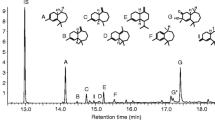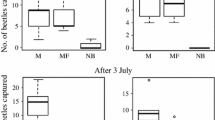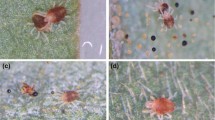Abstract
In the Ecuadorian cloud forest, males of the parasitoid braconid wasp Napo townsendi Shaw displayed facultative lekking, appearing both singly and in groups of 2–7 on the leaf tops of various plant species. To attract females, they constantly employed a stereotypical, spread-winged calling behaviour, apparently releasing a sex pheromone combed from the lateral metasomal exocrine glands and applied to the wings and hind legs. Aggregated males used the same posture in conspecific agonistic displays, often leading to physical fighting. While female wasps were attracted to and mated with displaying singletons, they also made a choice among aggregated males. When females approached, males vibrated their wings in a brief courtship and mounted. Details of copulation behaviour, which lasted on an average of 3–4 min, are described. Without apparent physical weaponry, the displaying wasps successfully warded off attacks from an assortment of predatory arthropods, particularly salticid spiders. We present case studies of repeated unsuccessful predation attempts by salticids. Here, we postulate that calling and release of sex pheromone may double as both an intrasexual agonistic display and an aposematic advisory to predators that the wasps employ a chemical defence.
Similar content being viewed by others
References
Abe Y., Nishimura T. and Maeto K. (2013) Causes of polymorphic melanism and its thermoregulatory function in a parasitoid wasp Meteorus pulchricornis (Hymenoptera: Braconidae). European Journal of Entomology 110, 627–632. doi: 10.14411/eje.2013.085.
Antolin M. E and Strand M. R. (1992) Mating system of Bracon hebetor (Hymenoptera: Braconidae). Ecological Entomology 17, 1–7. doi: 10.1111/j.1365-2311.1992.tb01032.x.
Ayasse M., Paxton R. J. and Tengo J. (2001) Mating behavior and chemical communication in the order Hymenoptera. Annual Review of Entomology 46, 31–78. doi: 10.1146/annurev.ento.46.1.31.
Benelli G., Bonsignori G., Stefanini C. and Canale A. (2012) Courtship and mating behaviour in the fruit fly parasitoid Psyttalia concolor (Szépligeti) (Hymenoptera: Braconidae): the role of wing fanning. Journal of Pest Science 85, 55–63. doi: 10.1007/sl0340-011-0394-x.
Benelli G., Bonsignori G., Stefanini C., Dario P. and Canale A. (2013) Male wing fanning performance during successful and unsuccessful mating in the parasitic wasp Lariophagus distinguendus Förster (Hymenoptera: Pteromalidae). Journal of Insect Behavior 26, 228–237. doi: 10.1007/sl0905-012-9356-2.
Benelli G., Giunti G., Canale A. and Messing R. H. (2014a) Lek dynamics and cues evoking mating behavior in tephritid flies infesting soft fruits: implications for behavior-based control tools. Applied Entomology and Zoology 49, 363–373. doi: 10.1007/sl3355-014-0276-9.
Benelli G., Kavallieratos N. G., Donati E., Mencattelli M., Bonsignori G., Stefanini C., Canale A. and Messing R. H. (2014b) May the wild male loose? Male wing fanning performances and mating success in wild and mass-reared strains of the aphid parasitoid Aphidius colemani Viereck (Hymenoptera: Braconidae: Aphidii-nae). BioControl 59, 487–500. doi: 10.1007/sl0526-014-9582-y.
Benelli G., Kavallieratos N. G., Donati E., Mencattelli M., Bonsignori G., Stefanini C, Canale A. and Messing R. H. (2014c) Erratum to: May the wild male lose? Male wing fanning performances and mating success in wild and mass-reared strains of the aphid parasitoid Aphidius colemani Viereck (Hymenoptera: Braconidae: Aphidiinae). BioControl 59, 501. doi: 10.1007/sl0526-014-9599-2.
Blum M. S. (1996) Semiochemical parsimony in the Arthropoda. Annual Review of Entomology 41, 353–374. doi: 10.1146/annurev.en.41.010196.002033.
Bradbury J. W. and Gibson R. M. (1983) Leks and mate choice, pp. 109–140. In Mate Choice (edited by P. Bateson). Cambridge University Press, Cambridge.
Bredlau J. P., Mohajer Y. J., Cameron T. M., Kester K. M. and Fine M. L. (2013) Characterization and generation of male courtship song in Cotesia congregata (Hymenoptera: Braconidae). PLOS ONE 8, e62051. doi: 10.1371/journal.pone.006251.
Buckingham G. R. and Sharkey J. (1988) Abdominal exocrine glands in Braconidae (Hymenoptera). Advances in Parasitic Hymenoptera Research 1988, 199–242.
Byers J. A. and Levi-Zada A. (2010) Individual variation of (S)-4-methyl-3-heptanone in heads of braconid wasp, Leiophron uniformis, and Pogonomyrmex ants indicates costs of semiochemical production. Chemoe-cology 21, 35–44. doi: 10.1007/s00049-010-0064-0.
Canale A., Benelli G., Lanzo F., Gianotti P., Mazzoni V. and Luchi A. (2013) The courtship song of fanning males in the fruit fly parasitoid Psyttalia concolor (Szépligeti) (Hymenoptera: Braconidae). Bulletin of Entomological Research 103, 303–309. doi: 10.1017/ S000748531200715.
Cossé A. A., Petroski R. J., Zilkowski B. W., Vermillion K., Lelito J. P., Cooperband M. F. and Gould J. R. (2012) Male-produced pheromone of Spathius agrili, a parasitoid introduced for the biological control of the invasive emerald ash borer, Agrilus planipennis. Journal of Chemical Ecology 38, 389–399. doi: 10.1007/S10886-012-0101-2.
Godfray H. C. J. (1994) Parasitoids: Behavioral and Evolutionary Ecology. Princeton University Press, Princeton, NJ, USA. 488 pp.
Godfray H. C. J. and Cook J. M. (1997) Mating systems of parasitoid wasps, pp. 211–225. In The Evolution of Mating Systems in Insects and Arachnids (edited by J. C. Choe and B. J. Crespi). Cambridge University Press, Cambridge.
Greeney H. F. (2010) Bimodal breeding seasonality of an understorey bird, Premnoplex brunnescens, in an Ecuadorian cloud forest. Journal of Tropical Ecology 26, 547–549. doi: 10.1017/S02664674100000295.
Hanson P. E. and Gauld I. D. (1995) The biology of the Hymenoptera, pp. 20–88. In The Hymenoptera of Costa Rica (edited by P. Hanson and I. D. Gauld). Oxford University Press, Oxford.
Joyce A. L., Bernai J. S., Bradleigh Vinson S. and Lomeli-Flores R. (2009) Influence of adult size on mate choice in the solitary and gregarious parasitoids, Cotesia marginiventris and Cotesia flavipes. Journal of Insect Behavior 22, 12–28. doi: 10.1007/sl0905-008-9149-9.
Joyce A. L., White W. H. and Medina R. F. (2014) Host plants impact courtship vibration transmission and mating success of a parasitoid wasp, Cotesia flavipes (Hymenoptera: Braconidae). Evolutionary Ecology 28, 361–372. doi: 10.1007/sl0682-013-9682-7.
Matthews R. W. (1974) Biology of Braconidae. Annual Review of Entomology 19, 15–32. doi: 10.1146/annur-ev.en.19.010174.000311.
Miller J. S. and Dyer L. (2009) Special feature: diversity of insect-plant interactions in the eastern Andes of Ecuador. Journal of Insect Science 9, 26. doi: 10.1673/ 031.009.2601.
Quicke D. L. J. (1990) Tergal and inter-tergal metasomal glands of male braconine wasps (Insecta, Hymenoptera, Braconidae). Zoologica Scripta 19, 413–423. doi: 10.1111/j.l463-6409.1990.tb00268.x.
Quicke D. L. J. (1997) Parasitic Wasps. Chapman & Hall, London. 470 pp.
Quicke D. L. J., Wharton R. A. and Sittertz-Bhatkar H. (1996) Recto-tergal fusion in the Braconinae (Hymenoptera: Braconidae): structure and distribution. Journal of Hymenoptera Research 5, 73–79.
Quicke D. L. J., Wharton R. A. and Sittertz-Bhatkar H. (1997) Anterolateral abdominal scent glands of braconine wasps (Hymenoptera: Braconidae). Journal of Hymenoptera Research 6, 219–230.
Quimio G. M. and Walter G. H. (2000) Swarming, delayed sexual maturation of males, and mating behavior of Fopius arisanus (Sonan) (Hymenoptera: Braconidae). Journal of Insect Behavior 13, 797–813. doi: 10.1023/ A:1007854332262.
Rab Green S. B., Gentry G. L., Greeney H. R and Dyer L. A. (2011) Ecology, natural history, and larval descriptions of Arctiinae (Lepidoptera: Noctuoidea: Erebidae) from a cloud forest in the eastern Andes of Ecuador. Annals of the Entomological Society of America 104, 1135–1138. http://dx.doi.org/10.1603/AN10165.
Ruther J. (2013) Novel insights into pheromone-mediated communication in parasitic hymenopterans, pp. 112–144. In Chemical Ecology of Insect Parasitoids (edited by E. Wajnberg and S. Colazza). Wiley-Blackwell, Hoboken, NJ.
Ruther J., Stahl L. M., Steiner S., Garbe L. A. and Tolasch T. (2007) A male sex pheromone in a parasitic wasp and control of the behavioral response by the female’s mating status. Journal of Experimental Biology 210, 2163–2169. doi: 10.1242/jeb.02789.
Seitner M. and Nötzl P. (1925) Pityophthorus henscheli Seitner und sein Parasit Cosmophorus henscheli Ruschka. Zeitschrift für Angewandte Entomologie 11, 187–195. doi: 10.1111/j.l439-0418.1925.tb00001.x.
Shaw M. R. (2009) A new, highly sexually dimorphic species of Cosmophorus Ratzeburg (Hymenoptera: Braconidae: Euphorinae) reared from Corsica. British Journal of Entomology and Natural History 22, 151–157.
Shaw S. R. (1991) An unusual manner of aggregation in the braconid Chelonus (Microchelonus) hadrogaster McComb (Hymenoptera). Journal of Insect Behavior 4, 537–542. doi: 10.1007/BF01049337.
Shaw S. R. (1995) Braconidae, pp. 431–463. In The Hymenoptera of Costa Rica (edited by P. E. Hanson and I. D. Gauld). Oxford University Press, Oxford.
Shaw S. R. (2012) A new genus and new species of the tribe Dinocampini from Napo Province in Ecuador (Hymenoptera: Braconidae: Euphorinae). International Journal of Tropical Insect Science 32, 101–107. doi: 10.1017/S1742758412000112.
Sheehan M. J. and Tibbetts E. A. (2011) Specialized face learning is associated with individual recognition in paper wasps. Science 334, 1272–1275. doi: 10.1126/ science.1211334.
Shelly T. E. and Whittier T. S. (1997) Lek behavior of insects, pp. 273–293. In Evolution of Mating Systems in Insects and Arachnids (edited by J. C. Choe and B. J. Crespi). Cambridge University Press, Cambridge.
Thornhill R. and Alcock J. (1983) The Evolution of Insect Mating Systems (edited by D. Schuker and L. Simmons). Harvard University Press, Cambridge.
Vulinec K. (1990) Collective security: aggregation by insects as a defense, pp. 251–288. In Insect Defenses: Adaptive Mechanisms and Strategies of Prey and Predators (edited by D. L. Evans and J. O. Schmidt). State University of New York Press, Albany, New York.
Author information
Authors and Affiliations
Corresponding author
Rights and permissions
About this article
Cite this article
Robinson, W.S., Dority, D.E., Kulikowski, A.J. et al. The recently described parasitoid braconid wasp, Napo townsendi (Hymenoptera: Braconidae: Euphorinae: Dinocampini), forms leks and deters predators in the Ecuadorian cloud forest. Int J Trop Insect Sci 35, 103–116 (2015). https://doi.org/10.1017/S1742758415000107
Accepted:
Published:
Issue Date:
DOI: https://doi.org/10.1017/S1742758415000107




